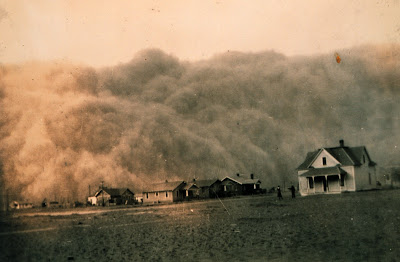Serious Post - Question on "Dust" in Hurricanes

Or what I call: Dusty Hurricanes...
The picture above is from the Dust Bowl, that is not a big afternoon thunderstorm but an explosive, rolling cloud of dust about to wipe out and cloak those poor little houses in darkness. Understand that the dust storms of the 30s were not one day events like a hurricane, they happened over and over for days, weeks.. months. It was an event that our generation cannot really fathom or compare to anything in our recent memory. Keep that picture in mind when reading this post and think on how many tons of sand, pounds... dust that was in the atmosphere the summer of 1935.
Okay so while reading some excellent articles that were posted on Hurricane City it made me wonder on the year 1935 and how the dust from the Dust Bowl *could* have possibly affected the hurricane season that brought us the very intense Labor Day Hurricane.
First I ask you to look at these 3 links and don't get lost surfing but come back to my question...
story http://science.nasa.gov/headlines/y2007/13apr_dustyhurricanes.htm
home page http://namma.msfc.nasa.gov/index.html
opposing view to first link
http://www.engr.wisc.edu/wiscengr/feb07/africandust.shtml
We see there are different opinons on whether dust from the Saharan Desert help or hinder hurricane development.
QUESTION:
Does African Saharan Dust and or the American kind from the Dust Bowl play a role in hurricane formation...and if so what role?
There was a tremendous amount of "dust" from the Dust Bowl after a few months where dust was so strong and powerful that cars in Washington DC were reported to have dust on their surfaces from the Dust Storms in Kansas and Oklahoma.
The scientists working the experiment currenly talk on how sunsets in America can be tinged with African dust and higher incidences of asthma are reported so far away from the Cape Verde Islands as dust travels far and affects many miles away.
Yet... the Atlantic Hurricane Basin wasn't all that far away from the dust of the Dust Bowl, the Dirty 30s and most specifically the 1935 outbreak.
Dust Bowl Primer Pics to take your breath away:
http://www.weru.ksu.edu/new_weru/multimedia/dustbowl/dustbowlpics.html
Note this paragraph from wiki "On November 11, 1933, a very strong dust storm stripped topsoil from desiccated South Dakota farmlands in just one of a series of bad dust storms that year. Then on May 11, 1934, a strong two-day dust storm removed massive amounts of Great Plains topsoil in one of the worst such storms of the Dust Bowl. The dust clouds blew all the way to Chicago where filth fell like snow, dumping the equivalent of four pounds of debris per person on the city. Several days later, the same storm reached cities in the east, such as Buffalo, Boston, New York City, and Washington, D.C. That winter, red snow fell on New England."
So..after a wild hurricane ride in 1933, a year similar to 2005..
http://weather.unisys.com/hurricane/atlantic/1933/index.html
We come to 1935 a year of feast or famine, wild and intense when a very small storm aka Labor Day Hurricane blew up quick and hard and became very deadly and considered for years to be the most intense hurricane ever. Shortly after that storm we develop a wrong way sort of storm infamous for going the wrong way for a long distance... not a common track for storms.
http://weather.unisys.com/hurricane/atlantic/1935/index.html
Does dust affect hurricane formation? IF SO.. HOW? Can it affect direction of movement? Size? Is it all about at what part of formation in the storm's creation the dust hits? Timing they say is everything..
How about Volcanic Hurricanes?
At 8:32 Sunday morning, May 18, 1980, Mount St. Helens erupted.
1980 Atlantic Hurricane starts off with a Cape Verde storm forming into one heck of a Category 5 storm... Formed July 31st in the Cape Verde region and headed west and kept going. The "A" storm ALLEN becomes the strongest hurricane of that season and many seasons after it.
http://weather.unisys.com/hurricane/atlantic/1980/index.html
Is there a connection or is this purely a coincidence?
How does dust or sand affect hurricanes?
How much do we know really?
How little do we know?
How much is there to gain in research that can be applied...
Is it a coincidence that Earth's atmosphere was so heavily laden with dusty, dirty particles of sand and or ash that both the deadliest 1935 dust bowl storms and a few months after Mt. St. Helens we had two of our strongest, most memorable hurricanes Allen and The 1935 Labor Day Storm.
Coincidence? Or things we don't yet understand?
PS... even wierder look at all the short tracks for 34 as we were ramping up into the dirtiest of the 30s.. like they ran out of gas too soon, too fast?
http://weather.unisys.com/hurricane/atlantic/1934/index.html
Dusty Canes? Something to think on, so much we really don't know.


0 Comments:
Post a Comment
<< Home